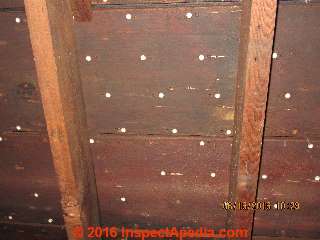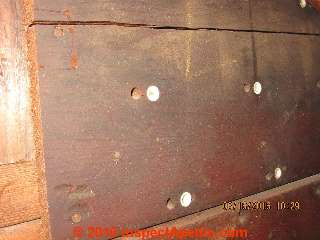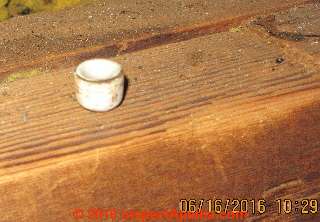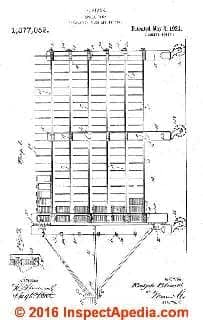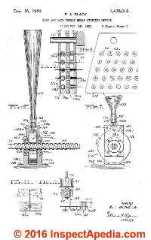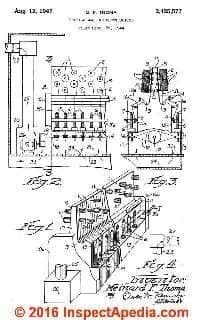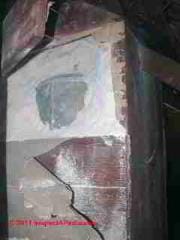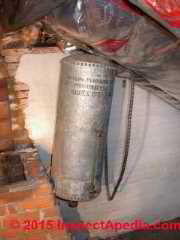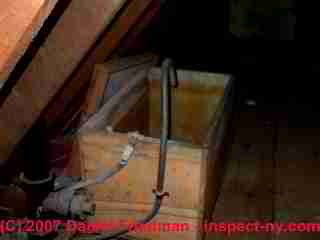 Old House Mysteries & Their Solutions
Old House Mysteries & Their Solutions
- POST a QUESTION or COMMENT about how to identify strange (to us) components or conditions in on or at buildings
Old house detective work:
Questions & answers identify old, odd, unusual components, conditions, problems, in, on or around older buildings. This article posts photographs of unidentified objects, components, systems found in older buildings. We include descriptions of the items or conditions observed and we speculate on the original source or purpose of the "thing" being studied.
We include research and research suggestions that help explain old building questions, observations, components, or materials whose original use, source, or purpose may be otherwise lost in the fog or murk of time. Page top photo: antique box found in the attic of the Justin Morrill Smith house seems to receive water and send it somewhere; it's too small to be a cistern.
InspectAPedia tolerates no conflicts of interest. We have no relationship with advertisers, products, or services discussed at this website.
- Daniel Friedman, Publisher/Editor/Author - See WHO ARE WE?
Old House Mysteries, Detectives, & Explanations
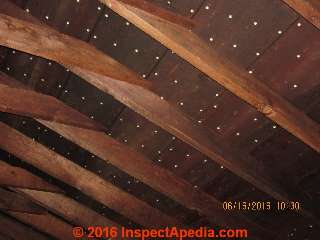 The attic water tank shown at the top of this page is described at ROOFTOP WATER TANKS under Attic Water Storage Tanks or Cisterns.
The attic water tank shown at the top of this page is described at ROOFTOP WATER TANKS under Attic Water Storage Tanks or Cisterns.
Below we start on a new old house mystery.
Perforated Board Roof Sheathing with Ceramic Insulating bushings - where did these boards come from?
Home owners, home inspectors and other building professionals enjoy figuring out the answer to "What the heck is that?" or similar exclamations that describe unidentified objects, systems, components or conditions in buildings.
Old building mysteries may involve a weird electrical control, a tank that has no apparent use, or things that just don't seem to belong. From objects to odors, sights to sounds, we publish those findings here along with the solutions to these puzzles.
[Click to enlarge any image]
Use the page top or bottom CONTACT link to send us email with your photographs, questions, or answers to old house mysteries.
Shown here, roof sheathing boards on a 1955 wood frame home. The boards are perforated at regular intervals and most of the perforations include a concave white ceramic bushing stamped 395/2.
2016/06/15: Professional home inspector and frequent contributor to InspectApedia David Grudzinski writes:
I have a strange find from a 1955 home today. The wood sheathing in the home and roof deck has hundreds of small Ceramic plugs installed, and I have no idea what that is, or what it may have been for. Attached are a few photos.
I took one of the plugs out and its concaved on one side, and has stamped numbers on the bottom. The stamped numbers are 395 over 2.
- David Grudzinski, Advantage Home Inspections, ASHI cert # 249089, HUD cert# H-145, is a professional home inspector who contributes on various topics including structural matters. David Grudzinski, Cranston RI serving both Rhode Island and Eastern Connecticut can be reached at 401-935-6547 fax- 401-490-0607 or by email to Davidgrudzinski@aol.com. Mr. Grudzinski is a regular contributor to InspectAPedia.com - see DECK FLASHING LEAKS, ROT Case Study, and BASEMENT WATER MOLD IMPACT and VERMICULITE INSULATION for examples.
Initial Speculation from DF:
Here's a working half-baked guess based on my discovery of a house built out of packing crates and some other recycled-material homes: I suspect that someone recycled maybe even stole these boards to use as roof sheathing from some prior application. That is I guess the holes and plugs had nothing functional to do with the house where you saw them.
Now the challenge is to find out what the heck those perforated boards were used for.
We have some clues:
- Age of the home suggest the boards were a 1950's or earlier application
- The holes are drilled in a regular diagonal pattern across each board, and the ceramic plug is not one we'd associate with K&T electrical wiring;
- There appear to be pairs of holes but no pairs of ceramic insulators occupying both members of the pair
- There is evidence that the boards were originally coated with a finish - I see some peeling in one of your photos
- There are a lot of these boards: they probably came from some large project
- Then there's the ceramic plug marked 395/2
Did you happen to note the dimensions, width, length of these boards? Do you know the plug and hole dimensions; sometimes those details help me come up with the original application.
Where is the home located? What industries were nearby in the 1950's? Do we know the occupation of the original owner (unlikely I realize) and do you think it was an owner-built house?
David Replies:
The home is 1955, in Cumberland RI, I do not know who built it, but its a standard style home we see lots of here in NE, a split level ranch.
The board width is near 14 inches and the length are 10 ft or better.
The plugs are 1/2 inch exactly. The boards do not all have them so I agree they were a salvage. I initially suspected some past association with radiant electric heat, but I would expect them to be uniformly around the house, and not on roof sheathing.
In This area there were textile mills, but I can't connect any textile to this application.
... I also find it odd that the ceramic plugs are numbered as that would seem counter productive for such an insignificant part unless it was a critical part. And one side being dimpled is strange unless it was to reflect heat back?
Below, David gives us a closer-look at the ceramic insulator, grommet or more likely "bushing".
DF replies
These boards came from some large industrial or research project, probably used indoors as the peeling finish looks like something that wasn't for outside. It seems to me these roof sheathing boards were "re-purposed" from some earlier application. Re-use of building materials in construction has a very long history.
And thinking like you I guess the source was local or local to the employment of whomever salvaged or re-purposed the boards. Covered by roofing there is no apparent reason that these insulated perforated boards would have sported those features specifically for use as roof sheathing, though I wouldn't rule out testing perforated boards as a substitute for spaced wood furring strips as a roof sheathing system onto which slates and other roofing plenty of needing ventilation. - Seems rather unlikely, though.
[Do we know the original roof material on this home?]
Ceramic suggests maybe electrical (or as you suggest a concern for static electricity) but size and number of boards makes it odder, perhaps salvaged from a large or one-off industrial project;
If some of the boards were flipped over it would be instructive to compare the other side, looking for a difference in finish or any material deposits. Wear marks or stampings on boards might also give a clue. The numbered ceramic part may have been made for wider application than just in the boards were we're seeing it.
Wood was a natural insulating material; The Blackstone Valley Electric Company in RI built one of the largest early transformers ever seen.
The material could also have been part of some study or machine built as a New Deal project.
I researched patents, ceramic bushings in wooden boards at intervals, &c. and came up with a few projects but nothing that looked right.
A look at photographs of early textile mills shows hundreds of rows of spools of texctile thread, usually placed vertically, at regular intervals. If these boards originated in a textile mill perhaps the bushings held spool spindles.
Examples of diagonally-placed peforations in boards used in textile mill applications: Spool Racks & Bobbin Boards, Bobbin Holders, Creels, Spindle Shanks using a porcelain eye, grommet or bushing
- Black, Ralph. "Spool-rack." U.S. Patent 1,377,052, issued May 3, 1921. Illustrated above. [Click to enlarge any image]
- Black, Eric A. "Warp and jack thread-break-stopping device." U.S. Patent 1,478,016, issued December 18, 1923. Illustrated above.
Excerpt: The present intention relates to all operations in knitting or weaving machines whereby a plurality of threads, called the worin is run from a spool frame, called the jee-lr through perforated guide plates, commonly named cbrasses onto a winding drum, which forms the main part of' a device, called the warp mill. - Berger, Emil J. "Yarn moistening and tensioning device." U.S. Patent 1,843,078, issued January 26, 1932.
- Edward, Vossen, and Edward M. Tellerman. "Yarn furnishing device." U.S. Patent 3,083,924, issued April 2, 1963.
Excerpt: Secured to motor housing 40 is a bracket 60 supporting a porcelain eye 62. - German, Freddie H. "Yarn tension and moisture control means for knitting machines." U.S. Patent 2,046,293, issued June 30, 1936.
- Peterson, Burt A. "Bobbin holding means." U.S. Patent 2,466,861, issued April 12, 1949.
- Roth, Henry Ling. Ancient Egyptian and Greek Looms. Library of Alexandria, 1913.
Excerpt: .. Fig. 19.—Wooden Peg, possibly used for holding the warp and breast beams ... A long piece of perforated wood described by Prof. ..
- Thoma, Meinard F., "Textile machine construction." U.S. Patent 2,425,577, issued August 12, 1947. Illustrated above.
Excerpt: The present invention relates to an improved construction for textile machines, such as are commonly employed for the performance of spinning, twisting and similar operations.
Home Inspection Educator Alan Carson Adds Questions
Clearly re-used from something big and probably industrial – I agree.
- Do the plugs sit flush on both sides or project? Were they intended to separate boards from something, each other?
- 14 inch wide boards would have been seen as valuable and slightly unusual even in 1995, I’m thinking.
- Softwood, I’m assuming? Perhaps 5/8 or ¾ inch thick?
- Ceramic is used as an electrical insulator. What else? Thermal insulator?
- If the plug is removed, does the hole go right through the board? I’m wondering if the boards supported things. Like yarn or thread.
- Are the plugs friction fit? Threaded? Other?
- Is it possible the plugs were removed and added to allow various yarn colors, sizes or types to pass through depending on what was being woven?
- Alan Carson is a principal with Carson Dunlop Associates, a Toronto home inspection & home inspection education & report writing firm.
Other Old House Resources & Research
- Also see listings atReferences or Citations at the end of this or any other InspectApedia article.
- Association for Preservation Technology International 3085 Stevenson Drive, Suite 200 Springfield, IL 62703 Tel: 217-529-9039 Fax: 217-529-9120 Email: info@apti.org, Website: www.apti.org/
- Building Technology Heritage Library (Web: https://archive.org/details/buildingtechnologyheritagelibrary ) , produced by the Association for Preservation Technology, is a superb resource for old building researchers, owners, or restorers. website: https://archive.org/details/buildingtechnologyheritagelibrary
This library offers large collection of books (over 8000 in July of 2016), catalogs and other documents that are provided free to the public in a variety of electronic forms such as in PDF format or as .epub documents. The collection includes documents that are rarely found in other libraries nor in other online collections for preservationists.
Excerpt:
The Building Technology Heritage Library (BTHL) is primarily a collection of American and Canadian, pre-1964 architectural trade catalogs, house plan books and technical building guides. Trade catalogs are an important primary source to document past design and construction practices. These materials can aid in the preservation and conservation of older structures as well as other research goals. About the Building Technology Heritage Library The BTHL contains materials from various private and institutional collections. These materials are rarely available in most architectural and professional libraries.
Example: we downloaded Colt Houses (1954), [PDF, 109 MB] containing house plans produced by W.H. Colt & Son, Ltd., Bethersden Nr. Ashford, Kent. In 1954, Colt timber houses, manufactured by Colt at the company's factory in the Kentish Weald had been sold since 1930. The company described their homes as: "... they must not be considered as resembling ordinary "prefabs." When erected, each house has an individual character and there is no feeling of mass production or standardisation."
Note: On the home page for each item, there is a section as the bottom called "Reviews" It will list previous comments or ask "Be the first person to write a review." Please comment about items, as this helps the library and association better understand their users.
Special thanks to Mike Jackson, FAIA American architect and InspectApedia reader for suggesting this superb resource. Mr. Jackson can be contacted by email at arch419@aol.com
The Second Story: tips for identifying mysterious objects in buildings
- Building Age: A good start to determining the identity, proper name-of, and purpose of mysterious things we find as parts of buildings or their mechanical systems begins with determining the building age. See AGE of a BUILDING, HOW to DETERMINE - home page.
For example, a visit to historical museums that display old farm tools, barn equipment, and construction tools will invariably present the visitor with devices whose purpose is not evident to a modern viewer. My youngest grandson knows how to perform a Google search for soccer rules but he would not be able to explain the functions of a carding machine if all of our lives depended on it. - Building Type & Location. Identify the building type, its age, location, and whatever you can of its history. Nearby industries may offer a clue about things you find in or on a building; we've found entire homes built from materials swiped from the New York City subway system during its construction.
I inspected a home framed entirely from wood packing crates that were produced for Western Printing, a Poughkeepsie, New York company. The packing crate boards sheathing the roof still bore the Western Printing stencil markings, and the framing intervals for structural components were determined by the standard dimensions of the pallets and crates from their original source. - Building Owners: Identify the building owners and their history. Knowing the occupation of the occupants often lends a clue or two to understanding what they left behind.
- Re-purposed items & materials: Notice when items have been re-purposed or re-cycled such as the perforated roof sheathing boards shown above. That helps avoid wasting time inventing unnecessary explanations.
Keep in mind that re-cycled or re-purposed materials in a building will often be much older than the structure itself. Antique post-and-beam barn beams, for example are re-used in even brand new homes. - Sunday-night special repairs: keep in mind that people often make emergency repairs using whatever is at hand rather than the part intended for the purpose. That's especially true when repairs are made late on a Sunday night when supply stores are closed and the repair object - a leak, no heat, no electricity for example - is urgent.
I've seen a boiler drain valve installed to "plug" a leak in the side of a galvanized steel antique water heater tank simply because the DIY plumber didn't have a pipe plug handy. Other than plugging a leaky tapping, the valve had no purpose whatsoever.
Watch out: be slow to remove, throw-away, or condemn components on buildings that you don't understand. It may have been necessary. Early in a plumbing career I removed an obviously unnecessary loop of piping on a side arm coil hot water system only to discover that my "clean-up" of "unneeded junk" on the heater caused complete loss of hot water: I had not understood how the piping worked or what it was for. - Ask someone older than you if they know what the object or system is.
- Patent research often can help track down eras of use of various building components as well as their inventors and the companies to which they inventions were assigned. Keep in mind that patent research reflects items and inventions after their use has become formalized and it won't give a full picture of the history of a building material or component and its use.
Previously on "Old House Mysteries" These Have Been Solved
Solar Water Heater in Attic
Above: a partial view of a mysterious attic tank construction. This device is described and was finally explained
at SOLAR WATER HEATER ANTIQUE - describing the purpose of a weird wood wrapped, gypsum-insulated tank in a 100-year-old Riverside California home attic.
Attic Expansion Tank for Hydronic Heating System Boiler
Above: a round galvanized cylinder hanging from rafters in an attic, next to an abandoned chimney and stamped with the name of a plumbing company, Poughkeepsie, New York, and Queen City Tanks. Nearby steel strapping held something else that has been removed. This tank is identified and explained
at ATTIC & ANTIQUE EXPANSION TANKS, HEATING.
First Generation Electrical Power Distribution in New York City
Above we're looking at the cut-end of what is most likely a section of original DC or continuous current distribution cabling salvaged from a NYC trench. At
at STEAM BOILERS GENERATORS CONTROLS, PRATT we explain that the Pratt steam room engineer and himself a collector and historian, Conrad Milster spotted these "pipes" while looking into a utility trench where Con Ed was doing some other work.
...
Continue reading at HISTORIC & OLD BUILDINGS or select a topic from the closely-related articles below, or see the complete ARTICLE INDEX.
Or see these
Recommended Articles
- AGE of a BUILDING, HOW to DETERMINE
- ANTIQUE CHEST Ricketts - Strause HISTORY - research tracks down the long history of an old wooden chest
- HOPPUS MEASURER - before carpenters were good at arithmetic
- NOISE / SOUND DIAGNOSIS & CURE - topic home, includes a discussion of ghost noises in or at buildings
- ODORS GASES SMELLS, DIAGNOSIS & CURE - home
- OLD ELECTRICAL WIRING TYPES - photo guide to older types of electrical wiring found in buildings
- SAW & AXE CUTS, TOOL MARKS, AGE
Suggested citation for this web page
OLD HOUSE MYSTERIES & SOLUTIONS at InspectApedia.com - online encyclopedia of building & environmental inspection, testing, diagnosis, repair, & problem prevention advice.
Or see this
INDEX to RELATED ARTICLES: ARTICLE INDEX to BUILDING AGE
Or use the SEARCH BOX found below to Ask a Question or Search InspectApedia
Ask a Question or Search InspectApedia
Try the search box just below, or if you prefer, post a question or comment in the Comments box below and we will respond promptly.
Search the InspectApedia website
Note: appearance of your Comment below may be delayed: if your comment contains an image, photograph, web link, or text that looks to the software as if it might be a web link, your posting will appear after it has been approved by a moderator. Apologies for the delay.
Only one image can be added per comment but you can post as many comments, and therefore images, as you like.
You will not receive a notification when a response to your question has been posted.
Please bookmark this page to make it easy for you to check back for our response.
IF above you see "Comment Form is loading comments..." then COMMENT BOX - countable.ca / bawkbox.com IS NOT WORKING.
In any case you are welcome to send an email directly to us at InspectApedia.com at editor@inspectApedia.com
We'll reply to you directly. Please help us help you by noting, in your email, the URL of the InspectApedia page where you wanted to comment.
Citations & References
In addition to any citations in the article above, a full list is available on request.
- In addition to citations & references found in this article, see the research citations given at the end of the related articles found at our suggested
CONTINUE READING or RECOMMENDED ARTICLES.
- Carson, Dunlop & Associates Ltd., 120 Carlton Street Suite 407, Toronto ON M5A 4K2. Tel: (416) 964-9415 1-800-268-7070 Email: info@carsondunlop.com. Alan Carson is a past president of ASHI, the American Society of Home Inspectors.
Thanks to Alan Carson and Bob Dunlop, for permission for InspectAPedia to use text excerpts from The HOME REFERENCE BOOK - the Encyclopedia of Homes and to use illustrations from The ILLUSTRATED HOME .
Carson Dunlop Associates provides extensive home inspection education and report writing material. In gratitude we provide links to tsome Carson Dunlop Associates products and services.


